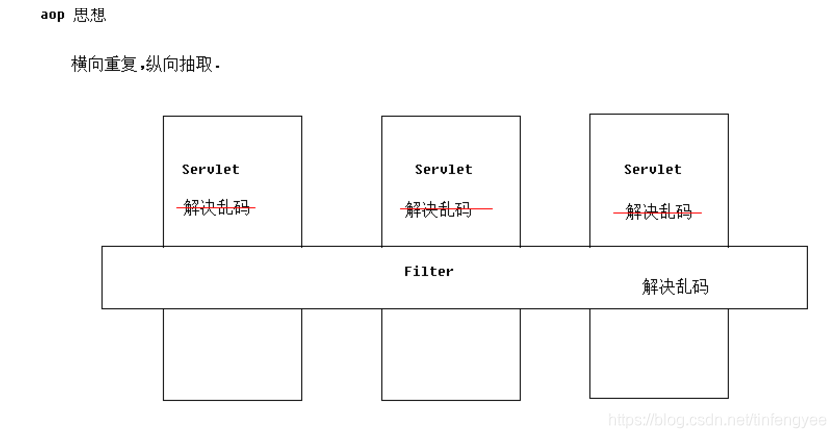AOP
AOP概念
思想介绍



spring实现aop的原理

名词学习

步骤(xml配置)
1.导包
4(核心)+2(Spring AOP)+2(第三方AOP)

2.准备目标对象
UseServiceImpl.java
package com.eilas.service;
public class UserServiceImpl implements UserService{
@Override
public void save() {
System.out.println("保存用户!");
//int i = 1/0;
}
@Override
public void delete() {
System.out.println("删除用户!");
}
@Override
public void update() {
System.out.println("更新用户!");
}
@Override
public void find() {
System.out.println("查找用户!");
}
}
3.准备通知
MyAdvice.java
package com.eilas.d_springaop;
import org.aspectj.lang.ProceedingJoinPoint;
public class MyAdvice {
//前置通知
// |-目标方法运行之前调用
//后置通知(如果出现异常不会调用)
// |-在目标方法运行之后调用
//环绕通知
// |-在目标方法之前和之后都调用
//异常拦截通知
// |-如果出现异常,就会调用
//后置通知(无论是否出现 异常都会调用)
// |-在目标方法运行之后调用
//----------------------------------------------------------------
//前置通知
public void before(){
System.out.println("这是前置通知!!");
}
//后置通知
public void afterReturning(){
System.out.println("这是后置通知(如果出现异常不会调用)!!");
}
//环绕通知
public Object around(ProceedingJoinPoint pjp) throws Throwable{
System.out.println("这是环绕通知之前的部分!!");
Object proceed = pjp.proceed();//调用目标方法
System.out.println("这是环绕通知之后的部分!!");
return proceed;
}
//异常通知
public void afterException(){
System.out.println("出事啦!出现异常了!!");
}
//后置异常通知
public void after(){
System.out.println("这是后置通知(出现异常也会调用)!!");
}
}
4.配置进行织入,将通知织入目标对象中
applicationContext.xml
<?xml version="1.0" encoding="UTF-8"?>
<beans xmlns="http://www.springframework.org/schema/beans"
xmlns:xsi="http://www.w3.org/2001/XMLSchema-instance"
xmlns:context="http://www.springframework.org/schema/context"
xmlns:aop="http://www.springframework.org/schema/aop"
xsi:schemaLocation="http://www.springframework.org/schema/beans
http://www.springframework.org/schema/beans/spring-beans.xsd
http://www.springframework.org/schema/context
http://www.springframework.org/schema/context/spring-context.xsd
http://www.springframework.org/schema/aop
http://www.springframework.org/schema/aop/spring-aop.xsd">
<!-- 准备工作: 导入aop(约束)命名空间 -->
<!-- 1.配置目标对象 -->
<bean name="userServiceTarget" class="com.eilas.service.UserServiceImpl"/>
<!-- 2.配置通知对象 -->
<bean name="myAdvice" class="com.eilas.d_springaop.MyAdvice"/>
<!-- 3.开启使用注解完成织入 -->
<aop:config>
<!--配置切入点
public void com.eilas.service.UserServiceImpl.save() //public可以省略
void com.eilas.service.UserServiceImpl.save() //一般不对返回值做要求
* com.eilas.service.UserServiceImpl.save() //但我们想不止对save方法做切入 ->
* com.eilas.service.UserServiceImpl.*() //但是这个必须是空参数的,我们想 ->
* com.eilas.service.UserServiceImpl.*(..) //对参数不做要求,但这个只针对UserServiceImpl类,
最终形态
* com.eilas.service.*ServiceImpl.*(..) //对服务类切入
* com.eilas.service..*ServiceImpl.*(..) //包括子包,但一般用不着
-->
<aop:pointcut id="pc" expression="execution(* com.eilas.service.*ServiceImpl.*(..))"/>
<aop:aspect ref="myAdvice">
<!--指定名为before方法作为前置通知-->
<aop:before method="before" pointcut-ref="pc"/>
<!--后置-->
<aop:after-returning method="afterReturning" pointcut-ref="pc"/>
<!--环绕-->
<aop:around method="around" pointcut-ref="pc"/>
<!--异常拦截-->
<aop:after-throwing method="afterException" pointcut-ref="pc"/>
<!--后置异常-->
<aop:after method="after" pointcut-ref="pc"/>
</aop:aspect>
</aop:config>
</beans>
MyAdvice.java
package com.eilas.d_springaop;
import org.aspectj.lang.ProceedingJoinPoint;
public class MyAdvice {
//前置通知
public void before(){
System.out.println("这是前置通知!!");
}
//后置通知
public void afterReturning(){
System.out.println("这是后置通知(如果出现异常不会调用)!!");
}
//环绕通知
public Object around(ProceedingJoinPoint pjp) throws Throwable{
System.out.println("这是环绕通知之前的部分!!");
Object proceed = pjp.proceed();//调用目标方法
System.out.println("这是环绕通知之后的部分!!");
return proceed;
}
//异常通知
public void afterException(){
System.out.println("出事啦!出现异常了!!");
}
//后置异常通知
public void after(){
System.out.println("这是后置通知(出现异常也会调用)!!");
}
}
5.测试
package com.eilas.d_springaop;
import com.eilas.service.UserService;
import org.junit.Test;
import org.junit.runner.RunWith;
import org.springframework.test.context.ContextConfiguration;
import org.springframework.test.context.junit4.SpringJUnit4ClassRunner;
import javax.annotation.Resource;
@RunWith(SpringJUnit4ClassRunner.class)
@ContextConfiguration("classpath:com/eilas/d_springaop/applicationContext.xml")
public class AopTest {
@Resource(name = "userService")
UserService us;
@Test
public void test01() {
us.save();
}
}
步骤(注解)
1,2,一样
3.注解通知
package com.eilas.e_annotationaop;
import org.aspectj.lang.ProceedingJoinPoint;
import org.aspectj.lang.annotation.*;
//通知类 //表示该类是一个通知类
@Aspect
public class MyAdvice {
@Pointcut("execution(* com.eilas.service.*ServiceImpl.*(..))")
public void pc() {}
//前置通知
// |-目标方法运行之前调用
//后置通知(如果出现异常不会调用)
// |-在目标方法运行之后调用
//环绕通知
// |-在目标方法之前和之后都调用
//异常拦截通知
// |-如果出现异常,就会调用
//后置通知(无论是否出现 异常都会调用)
// |-在目标方法运行之后调用
//----------------------------------------------------------------
//前置通知
//指定该方法是前置通知,并制定切入点
@Before("MyAdvice.pc()")
public void before(){
System.out.println("这是前置通知!!");
}
//后置通知
@AfterReturning("execution(* com.eilas.service.*ServiceImpl.*(..))")
public void afterReturning(){
System.out.println("这是后置通知(如果出现异常不会调用)!!");
}
//环绕通知
@Around("execution(* com.eilas.service.*ServiceImpl.*(..))")
public Object around(ProceedingJoinPoint pjp) throws Throwable{
System.out.println("这是环绕通知之前的部分!!");
Object proceed = pjp.proceed();//调用目标方法
System.out.println("这是环绕通知之后的部分!!");
return proceed;
}
//异常通知
@AfterThrowing("execution(* com.eilas.service.*ServiceImpl.*(..))")
public void afterException(){
System.out.println("出事啦!出现异常了!!");
}
//后置异常通知
@After("execution(* com.eilas.service.*ServiceImpl.*(..))")
public void after(){
System.out.println("这是后置通知(出现异常也会调用)!!");
}
}
4.配置进行织入,将通知织入目标对象中
<?xml version="1.0" encoding="UTF-8"?>
<beans xmlns="http://www.springframework.org/schema/beans"
xmlns:xsi="http://www.w3.org/2001/XMLSchema-instance"
xmlns:aop="http://www.springframework.org/schema/aop"
xsi:schemaLocation="http://www.springframework.org/schema/beans
http://www.springframework.org/schema/beans/spring-beans.xsd
http://www.springframework.org/schema/aop
http://www.springframework.org/schema/aop/spring-aop.xsd">
<!-- 准备工作: 导入aop(约束)命名空间 -->
<!-- 1.配置目标对象 -->
<bean name="userService" class="com.eilas.service.UserServiceImpl"/>
<!-- 2.配置通知对象 -->
<bean name="myAdvice" class="com.eilas.e_annotationaop.MyAdvice"/>
<!-- 3.开启使用注解完成织入 -->
<aop:aspectj-autoproxy/>
</beans>
5.测试
package com.eilas.e_annotationaop;
import com.eilas.service.UserService;
import org.junit.Test;
import org.junit.runner.RunWith;
import org.springframework.test.context.ContextConfiguration;
import org.springframework.test.context.junit4.SpringJUnit4ClassRunner;
import javax.annotation.Resource;
@RunWith(SpringJUnit4ClassRunner.class)
@ContextConfiguration("classpath:com/eilas/e_annotationaop/applicationContext.xml")
public class AopTest {
@Resource(name = "userService")
UserService us;
@Test
public void test01() {
us.save();
}
}
